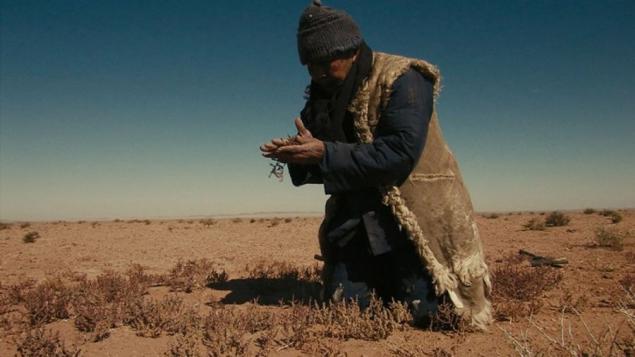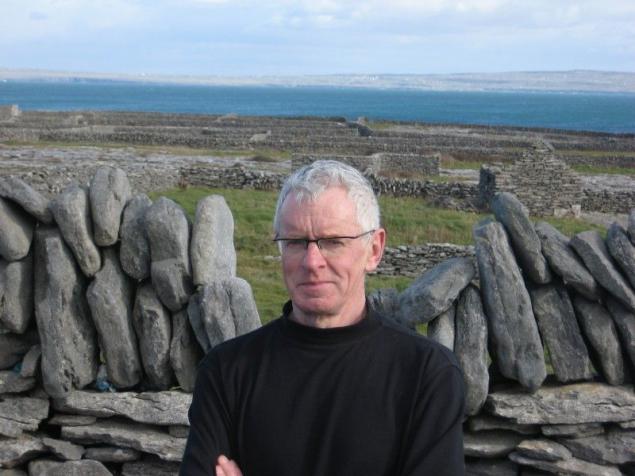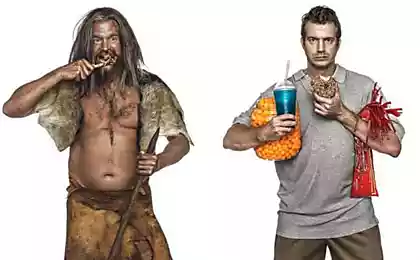1450
10 cases of global hunger, leading to cannibalism (14 photos)
Hunger - an acute shortage of food. Hunger leads to depletion and increased mortality among the population. The main causes of this disaster may be too rapid population growth, poor harvest, cold or even government policy. Nowadays, people have learned to deal with it with the help of an advanced agriculture.
Thanks to the progress made it easier to feed people, but in the Middle Ages, it was easy: all over the world often raging hunger, in addition, people have died due to various diseases and cold. It is estimated that even in the enlightened XX-th century have died of hunger about 70 million people. The scary thing is that the hunger people can go crazy and start to have other people in order to survive - in the history described many such cases.
The labor camp "Ditch»

"Ditch" - is a former labor camp, located in the north-western desert area of Gansu province, China. In the period from 1957 till 1961 3000 political prisoners are held - in a sort of concentration camp were sent to re-education of people, who were suspected of "right».
The original prison was designed only 40-50 offenders. Since autumn 1960 the camp was raging famine: people ate leaves, bark of trees, worms, insects, rats, waste, and finally resorted to cannibalism.

Yan Syanhuey
By 1961, died in 2500 of 3,000 prisoners, and the 500 people who survived had to eat dead people. Their stories are written in the book of Jana Syanhueya, then traveled around the north-western China desert, interviewing those who lived through this nightmare. The book turned slightly fictionalized and includes a graphic section in which people eat the body or other people's feces.
However, cannibalism in the "ditch" was real, even too much. In most cases, the bodies were so skinny that they were hard to eat. Events in the "ditch" is reflected in the eponymous film about people who have to cope with physical exhaustion, hypothermia, starvation and death.
Hunger in Jamestown

Jamestown was the first permanent English settlement in America. The settlement was established May 24, 1607, the year of the London campaign. Jamestown served as the capital of the colony until 1699, the year, and then it was moved to Williamsburg.
The town is located on the territory of Pouhatanskoy Confederation of Indian tribes - lived here about 14 thousand native Indians and European settlers had to rely on trade with them, buying more food was nowhere. But after a series of conflicts over trade.
In 1609, the year the disaster occurred: the third food ship bound for Jamestown from England crashed and got stuck on reefs of Bermuda. Ship luck to the village food, but because of the collapse of Jamestown was the winter without food. Later it became known that Captain Samuel Argall returned to England and warned officials about the plight of Jamestown, but to the shores of America is no longer sent to a single ship.

Samuel Argall
In winter 1609, the year famine erupted hundreds of colonists died a horrible death, and in 1610 of 500 men survived only 60. Excavations show that the survivors resorted to cannibalism - on human bones were found nicks showing cutting the muscle to the bone . Also found was a female skull with holes on the forehead and back of the head, suggesting that someone had tried to literally eat the brains of the dead woman. How Jamestown was widespread cannibalism is unclear.
The Great Famine 1315-1317

In the Middle Ages in Europe, the famine happens very often, as a rule, it was due to the poor harvest, overpopulation and diseases like the plague. Britain, for example, during the Middle Ages experienced 95 cases of mass starvation. In the period from 1348 till 1375, life expectancy in England averaged only 17, 33 years.
From 1310 till 1330 the weather in northern Europe was very bad and totally unpredictable. In 1315, the year sharply higher food prices, which caused the spread of hunger. In some places, the price tripled, and people had to eat wild plants, roots, herbs, nuts, and bark. In 1317, thousands of people die every week, and for three years the famine has killed millions.
Community rules in the famine ceased to operate - many parents abandon their children. In fact, this time formed the basis of the famous fairy tale "Hansel and Gretel." Some parents while their children were killed and ate them. There is also evidence that prisoners had to eat the corpses of other prisoners, and some people even stole the body from the grave.
The Siege of Leningrad

In June 1941, Nazi Germany attacked the Soviet Union, will launch a plan "Barbarossa" - the largest military invasion in history. The plan had to first capture Leningrad, then the Donets Basin, and then to Moscow.
Leningrad was needed to Hitler because of its military importance, the industry, as well as the symbolic past. With the help of the Finnish army, the Nazis surrounded the town and kept him in the siege of 872 days. The Germans wanted to force people to surrender the city, Zamora their hunger, and cut off all food supplies.
People had to live without utilities (water and energy). In the modern history of the blockade is the largest cause of death. It has been estimated that about 1, 5 million people have died as a direct result of the siege. Of the original 3, 5 million people, lived in Leningrad, only 700,000 survived the war.
Shortly after the start of the siege all the shops in town were closed. As expected, the money did not cost anything more. To steal food, even people huddled in groups. As a result, people had to eat the skin, fur, lipstick, spices and drugs, but hunger became more ferocious. Public law meant gradually smaller, and there were reports on the distribution of cannibalism.
During the siege of cannibalism has reached such proportions that the police had to organize a special unit to catch the "predators". Despite the fact that everything is lived in fear of a potential bombing, families were forced to fight even with this threat. After the war, scientists have started to use this information to study the famine, starvation and related diseases.
The Great Famine in Ireland

The Great Famine was a period of famine, which broke out in Ireland between 1845 m and 1852 m year. It is also known as the Irish potato famine, because the potato blight was the direct cause of the food shortages.
As in many cases, this was due to the stupid government reforms, because of which some historians call this event as genocide. Despite the fact that around one million people died of starvation and another million fled Ireland, the British government could not help.
Hunger has forever changed the demographic and political landscape of Ireland. He became the cause of strained relations between Ireland and the British crown, and eventually led to the independence of Ireland. During the famine of the vast majority of undernourished people in Ireland, because of what the terrible spread of infection. Some of the most deadly diseases were measles, tuberculosis, respiratory infections, whooping cough and cholera.

Cormac O'Grady
In 2012, Professor Cormac O'Grady of Dublin University suggested that during the Great Famine was widespread cannibalism. O'Grady was based on a series of written evidence, for example, the story of John Connolly from the west of Ireland, who ate meat from the body of her dead son.
Another case was published on May 23, 1849, the year and talked about a hungry man, "to pull out the heart and liver of a drowned man, who was washed ashore after a shipwreck." In some cases, acute hunger forced people to have a family member.
Battle in Suyyan

In the 757th year between the rebel army and Yang forces loyal army Tan battle took place at Suyyan. During the battle, Yang tried to besiege the area Suyyan to take control of the territory south of the Huai River. Tang Yan heavily outnumbered in force, but to defeat the enemy, they had to penetrate the thick walls. For the defense of the city posted general Zhang Xun.
In Zhang Xun was 7,000 troops to protect the Suyyan, while in the camp Yan was 150 000. Despite the siege and daily assaults, the army managed to hold back the onslaught of the Tang Yan for many months. However, by August 757-year all the animals, insects and plants in the city were eaten. Zhang Xun tried several times to get food from nearby fortresses, but one did not come to the aid. Before the death of hungry people tried to persuade Zhang Xun to surrender, but he refused.
According to the old book Tan, when food in Suyyan over, "people began to eat the dead bodies, and sometimes kill their own children." Xun Zhang admitted that the situation has become critical, so killed his assistant, and invited other to eat his body. At first, the soldiers refused, but soon he shamelessly ate flesh. So, first eaten all the women in the city, and when women are over, the soldiers began to hunt for old and young. A total ease, according to the Book of Tang, the soldiers killed and ate from 20 000 to 30 000 people.
Eater in Suyyan it became too much, and by that time, Yang took the city, survived a total of 400 people. Ian tried to persuade Zhang Xun to join their ranks, but he refused and was killed. Three days after the fall of the Tang Suyyan large army arrived and won over the area that was the beginning of the fall of the Great Yang.
Famine in North Korea

In the late 1980s, the Soviet Union demanded that North Korea compensation for all their help - past and present. In 1991, when the USSR collapsed, trade between the two countries ceased and the economy of North Korea is reflected in failure - the country could no longer produce enough food to feed the entire population, and in North Korea between 1994 and 1998, the year He suffered a massive famine that killed 250 000 to 3, 5 million people. It is especially difficult for women, and had small children.
Take the meat was hard, and some people have resorted to cannibalism. People began to treat food sellers with great suspicion, and the children were not allowed on the streets at night. There are reports that "people from hunger went mad, and even kill and eat their own babies, robbed graves and ate the corpses." The parents were in a panic: their children could have been abducted, killed and sold as meat.
In 2013, the year began to report that in North Korea because of the economic sanctions, famine again. The lack of food was the reason that the people were forced to again resort to cannibalism. One report says that a man was caught and his grandson who dug up the corpse for the sake of food. According to another report, a group of captured men who brewed children. Due to the fact that North Korea is still going on within the country keeps a secret, the government has not confirmed nor denied recent reports of cannibalism.
Holodomor

In the early 1930s, the Soviet government decided that all individual farms more profitable to replace collective. This was to increase the food supply, but instead led to one of the greatest famines in history. The collectivization of the land meant that farmers were forced to sell most of their harvest at a very low price. Workers also have their crops forbidden.
In 1932 the Soviet Union was not able to produce enough grain, and the country experienced a massive famine that killed millions. Hardest-hit areas such as the Ukraine, the North Caucasus, Kazakhstan, southern Urals and Western Siberia. In Ukraine, the famine was especially fierce. The stories he kept under the name of the Holodomor. Famine killed from three to five million people, and according to the data of the Kiev Court of Appeal, it was ten million deaths, including 3, 9 million victims and 6, 1 million birth defects.
During Holodomor was widespread cannibalism. People huddled in gangs, killed their families and ate the dead children. Soviet officials released posters with inscriptions: "To eat their own children - the barbarism».
In one case, a man named Myron Yemets and his wife were seized by cooking food their children, and sentenced to ten years in prison. It has been estimated that during the Great Famine of cannibalism were arrested about 2,500 people, the vast majority of them because of the famine were crazy.
The famine in the Volga region

In 1917, at the end of the First World War, in Russia the civil war between the Bolshevik Red Army and the White Army. During this time, political chaos, extreme violence and economic isolation of Russia caused the spread of disease and food shortages in many areas.
By 1921 in Bolshevik Russia a limited food supply and drought caused a famine that threatened the lives of over 25 million people in the Volga and Ural regions. By the end of 1922 the famine killed about five to ten million people.
During the famine of thousands of Soviet citizens were leaving their homes in search of food. People had to eat grass, dirt, insects, cats, dogs, clay, horse harness, carrion, animal skins and eventually resort to cannibalism. A lot of people were eating their family members and were hunting for human flesh.
Cases of cannibalism reported to the police, but she did not do anything, because the method was considered cannibalism to survive. According to one report, the woman was caught for cooking human flesh. She later admitted that she had killed her daughter for the sake of food.
It was reported that the police were forced to protect the cemetery, being attacked hungry crowds. People started to sell human organs on the black market, and cannibalism became a problem in prisons. Unlike most historical cases of cannibalism were even cannibals pictures, which show the starving people sitting near the ravaged human bodies. There is also evidence that people kill abandoned children to eat.
Great Chinese Famine

In the period of 1958 to 1961 in China broke famine. Food deficit was caused by drought, bad weather and big jumps - economic and political campaign of the Chinese government. According to official statistics killed around 15 million people.
Historian Frank Dikotter suggested that killed at least 45 million people. Almost all citizens of China was not enough food, the birth rate has decreased to a minimum. In China, this period is called the three bitter years.

Frank Dikotter
When the situation became worse, the Chinese leader Mao Zedong committed crimes against the people, he and his subordinates were stealing food and left millions of peasants to starve. Doctors were forbidden to specify the "hunger" as the cause of death.
A man named Yu Dehong said: "I came into a village and saw 100 corpses. In another village it was still 100 corpses. No one paid attention to them. People said that dogs eating corpses. Not true, I said. Dogs have long been the people ate. " A huge number of people went mad from hunger and violence.
During the great famine were widespread reports of cannibalism. People have lost all moral principles and often ate human flesh. Some were eating their children, other children have changed not to feel terrible about what their eating. Most of the food in China, it was human flesh, and some areas of the country were inhabited by cannibals. Cannibalism during this famine has been called "an unprecedented case in the history of XX-th century."
Thanks to the progress made it easier to feed people, but in the Middle Ages, it was easy: all over the world often raging hunger, in addition, people have died due to various diseases and cold. It is estimated that even in the enlightened XX-th century have died of hunger about 70 million people. The scary thing is that the hunger people can go crazy and start to have other people in order to survive - in the history described many such cases.
The labor camp "Ditch»

"Ditch" - is a former labor camp, located in the north-western desert area of Gansu province, China. In the period from 1957 till 1961 3000 political prisoners are held - in a sort of concentration camp were sent to re-education of people, who were suspected of "right».
The original prison was designed only 40-50 offenders. Since autumn 1960 the camp was raging famine: people ate leaves, bark of trees, worms, insects, rats, waste, and finally resorted to cannibalism.

Yan Syanhuey
By 1961, died in 2500 of 3,000 prisoners, and the 500 people who survived had to eat dead people. Their stories are written in the book of Jana Syanhueya, then traveled around the north-western China desert, interviewing those who lived through this nightmare. The book turned slightly fictionalized and includes a graphic section in which people eat the body or other people's feces.
However, cannibalism in the "ditch" was real, even too much. In most cases, the bodies were so skinny that they were hard to eat. Events in the "ditch" is reflected in the eponymous film about people who have to cope with physical exhaustion, hypothermia, starvation and death.
Hunger in Jamestown

Jamestown was the first permanent English settlement in America. The settlement was established May 24, 1607, the year of the London campaign. Jamestown served as the capital of the colony until 1699, the year, and then it was moved to Williamsburg.
The town is located on the territory of Pouhatanskoy Confederation of Indian tribes - lived here about 14 thousand native Indians and European settlers had to rely on trade with them, buying more food was nowhere. But after a series of conflicts over trade.
In 1609, the year the disaster occurred: the third food ship bound for Jamestown from England crashed and got stuck on reefs of Bermuda. Ship luck to the village food, but because of the collapse of Jamestown was the winter without food. Later it became known that Captain Samuel Argall returned to England and warned officials about the plight of Jamestown, but to the shores of America is no longer sent to a single ship.

Samuel Argall
In winter 1609, the year famine erupted hundreds of colonists died a horrible death, and in 1610 of 500 men survived only 60. Excavations show that the survivors resorted to cannibalism - on human bones were found nicks showing cutting the muscle to the bone . Also found was a female skull with holes on the forehead and back of the head, suggesting that someone had tried to literally eat the brains of the dead woman. How Jamestown was widespread cannibalism is unclear.
The Great Famine 1315-1317

In the Middle Ages in Europe, the famine happens very often, as a rule, it was due to the poor harvest, overpopulation and diseases like the plague. Britain, for example, during the Middle Ages experienced 95 cases of mass starvation. In the period from 1348 till 1375, life expectancy in England averaged only 17, 33 years.
From 1310 till 1330 the weather in northern Europe was very bad and totally unpredictable. In 1315, the year sharply higher food prices, which caused the spread of hunger. In some places, the price tripled, and people had to eat wild plants, roots, herbs, nuts, and bark. In 1317, thousands of people die every week, and for three years the famine has killed millions.
Community rules in the famine ceased to operate - many parents abandon their children. In fact, this time formed the basis of the famous fairy tale "Hansel and Gretel." Some parents while their children were killed and ate them. There is also evidence that prisoners had to eat the corpses of other prisoners, and some people even stole the body from the grave.
The Siege of Leningrad

In June 1941, Nazi Germany attacked the Soviet Union, will launch a plan "Barbarossa" - the largest military invasion in history. The plan had to first capture Leningrad, then the Donets Basin, and then to Moscow.
Leningrad was needed to Hitler because of its military importance, the industry, as well as the symbolic past. With the help of the Finnish army, the Nazis surrounded the town and kept him in the siege of 872 days. The Germans wanted to force people to surrender the city, Zamora their hunger, and cut off all food supplies.
People had to live without utilities (water and energy). In the modern history of the blockade is the largest cause of death. It has been estimated that about 1, 5 million people have died as a direct result of the siege. Of the original 3, 5 million people, lived in Leningrad, only 700,000 survived the war.
Shortly after the start of the siege all the shops in town were closed. As expected, the money did not cost anything more. To steal food, even people huddled in groups. As a result, people had to eat the skin, fur, lipstick, spices and drugs, but hunger became more ferocious. Public law meant gradually smaller, and there were reports on the distribution of cannibalism.
During the siege of cannibalism has reached such proportions that the police had to organize a special unit to catch the "predators". Despite the fact that everything is lived in fear of a potential bombing, families were forced to fight even with this threat. After the war, scientists have started to use this information to study the famine, starvation and related diseases.
The Great Famine in Ireland

The Great Famine was a period of famine, which broke out in Ireland between 1845 m and 1852 m year. It is also known as the Irish potato famine, because the potato blight was the direct cause of the food shortages.
As in many cases, this was due to the stupid government reforms, because of which some historians call this event as genocide. Despite the fact that around one million people died of starvation and another million fled Ireland, the British government could not help.
Hunger has forever changed the demographic and political landscape of Ireland. He became the cause of strained relations between Ireland and the British crown, and eventually led to the independence of Ireland. During the famine of the vast majority of undernourished people in Ireland, because of what the terrible spread of infection. Some of the most deadly diseases were measles, tuberculosis, respiratory infections, whooping cough and cholera.

Cormac O'Grady
In 2012, Professor Cormac O'Grady of Dublin University suggested that during the Great Famine was widespread cannibalism. O'Grady was based on a series of written evidence, for example, the story of John Connolly from the west of Ireland, who ate meat from the body of her dead son.
Another case was published on May 23, 1849, the year and talked about a hungry man, "to pull out the heart and liver of a drowned man, who was washed ashore after a shipwreck." In some cases, acute hunger forced people to have a family member.
Battle in Suyyan

In the 757th year between the rebel army and Yang forces loyal army Tan battle took place at Suyyan. During the battle, Yang tried to besiege the area Suyyan to take control of the territory south of the Huai River. Tang Yan heavily outnumbered in force, but to defeat the enemy, they had to penetrate the thick walls. For the defense of the city posted general Zhang Xun.
In Zhang Xun was 7,000 troops to protect the Suyyan, while in the camp Yan was 150 000. Despite the siege and daily assaults, the army managed to hold back the onslaught of the Tang Yan for many months. However, by August 757-year all the animals, insects and plants in the city were eaten. Zhang Xun tried several times to get food from nearby fortresses, but one did not come to the aid. Before the death of hungry people tried to persuade Zhang Xun to surrender, but he refused.
According to the old book Tan, when food in Suyyan over, "people began to eat the dead bodies, and sometimes kill their own children." Xun Zhang admitted that the situation has become critical, so killed his assistant, and invited other to eat his body. At first, the soldiers refused, but soon he shamelessly ate flesh. So, first eaten all the women in the city, and when women are over, the soldiers began to hunt for old and young. A total ease, according to the Book of Tang, the soldiers killed and ate from 20 000 to 30 000 people.
Eater in Suyyan it became too much, and by that time, Yang took the city, survived a total of 400 people. Ian tried to persuade Zhang Xun to join their ranks, but he refused and was killed. Three days after the fall of the Tang Suyyan large army arrived and won over the area that was the beginning of the fall of the Great Yang.
Famine in North Korea

In the late 1980s, the Soviet Union demanded that North Korea compensation for all their help - past and present. In 1991, when the USSR collapsed, trade between the two countries ceased and the economy of North Korea is reflected in failure - the country could no longer produce enough food to feed the entire population, and in North Korea between 1994 and 1998, the year He suffered a massive famine that killed 250 000 to 3, 5 million people. It is especially difficult for women, and had small children.
Take the meat was hard, and some people have resorted to cannibalism. People began to treat food sellers with great suspicion, and the children were not allowed on the streets at night. There are reports that "people from hunger went mad, and even kill and eat their own babies, robbed graves and ate the corpses." The parents were in a panic: their children could have been abducted, killed and sold as meat.
In 2013, the year began to report that in North Korea because of the economic sanctions, famine again. The lack of food was the reason that the people were forced to again resort to cannibalism. One report says that a man was caught and his grandson who dug up the corpse for the sake of food. According to another report, a group of captured men who brewed children. Due to the fact that North Korea is still going on within the country keeps a secret, the government has not confirmed nor denied recent reports of cannibalism.
Holodomor

In the early 1930s, the Soviet government decided that all individual farms more profitable to replace collective. This was to increase the food supply, but instead led to one of the greatest famines in history. The collectivization of the land meant that farmers were forced to sell most of their harvest at a very low price. Workers also have their crops forbidden.
In 1932 the Soviet Union was not able to produce enough grain, and the country experienced a massive famine that killed millions. Hardest-hit areas such as the Ukraine, the North Caucasus, Kazakhstan, southern Urals and Western Siberia. In Ukraine, the famine was especially fierce. The stories he kept under the name of the Holodomor. Famine killed from three to five million people, and according to the data of the Kiev Court of Appeal, it was ten million deaths, including 3, 9 million victims and 6, 1 million birth defects.
During Holodomor was widespread cannibalism. People huddled in gangs, killed their families and ate the dead children. Soviet officials released posters with inscriptions: "To eat their own children - the barbarism».
In one case, a man named Myron Yemets and his wife were seized by cooking food their children, and sentenced to ten years in prison. It has been estimated that during the Great Famine of cannibalism were arrested about 2,500 people, the vast majority of them because of the famine were crazy.
The famine in the Volga region

In 1917, at the end of the First World War, in Russia the civil war between the Bolshevik Red Army and the White Army. During this time, political chaos, extreme violence and economic isolation of Russia caused the spread of disease and food shortages in many areas.
By 1921 in Bolshevik Russia a limited food supply and drought caused a famine that threatened the lives of over 25 million people in the Volga and Ural regions. By the end of 1922 the famine killed about five to ten million people.
During the famine of thousands of Soviet citizens were leaving their homes in search of food. People had to eat grass, dirt, insects, cats, dogs, clay, horse harness, carrion, animal skins and eventually resort to cannibalism. A lot of people were eating their family members and were hunting for human flesh.
Cases of cannibalism reported to the police, but she did not do anything, because the method was considered cannibalism to survive. According to one report, the woman was caught for cooking human flesh. She later admitted that she had killed her daughter for the sake of food.
It was reported that the police were forced to protect the cemetery, being attacked hungry crowds. People started to sell human organs on the black market, and cannibalism became a problem in prisons. Unlike most historical cases of cannibalism were even cannibals pictures, which show the starving people sitting near the ravaged human bodies. There is also evidence that people kill abandoned children to eat.
Great Chinese Famine

In the period of 1958 to 1961 in China broke famine. Food deficit was caused by drought, bad weather and big jumps - economic and political campaign of the Chinese government. According to official statistics killed around 15 million people.
Historian Frank Dikotter suggested that killed at least 45 million people. Almost all citizens of China was not enough food, the birth rate has decreased to a minimum. In China, this period is called the three bitter years.

Frank Dikotter
When the situation became worse, the Chinese leader Mao Zedong committed crimes against the people, he and his subordinates were stealing food and left millions of peasants to starve. Doctors were forbidden to specify the "hunger" as the cause of death.
A man named Yu Dehong said: "I came into a village and saw 100 corpses. In another village it was still 100 corpses. No one paid attention to them. People said that dogs eating corpses. Not true, I said. Dogs have long been the people ate. " A huge number of people went mad from hunger and violence.
During the great famine were widespread reports of cannibalism. People have lost all moral principles and often ate human flesh. Some were eating their children, other children have changed not to feel terrible about what their eating. Most of the food in China, it was human flesh, and some areas of the country were inhabited by cannibals. Cannibalism during this famine has been called "an unprecedented case in the history of XX-th century."























